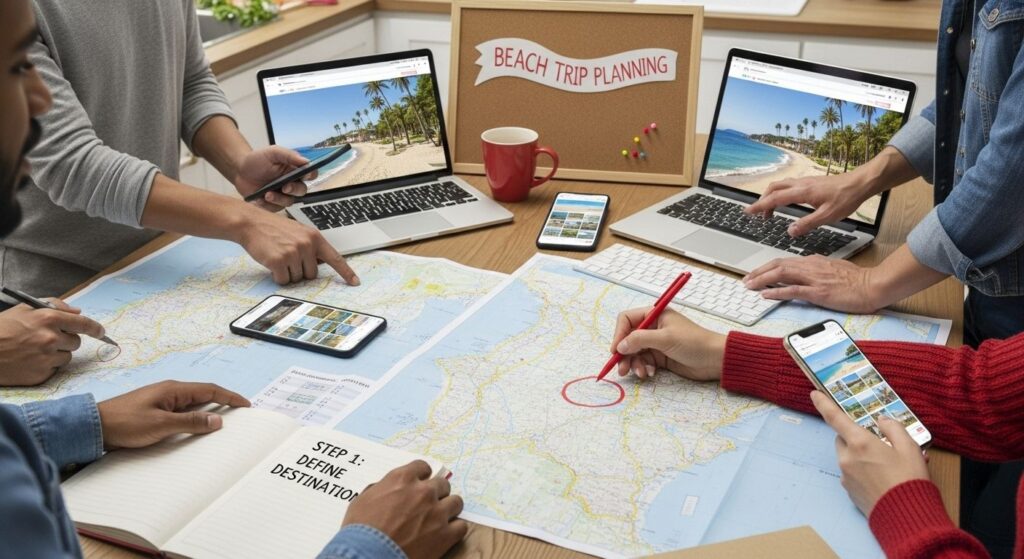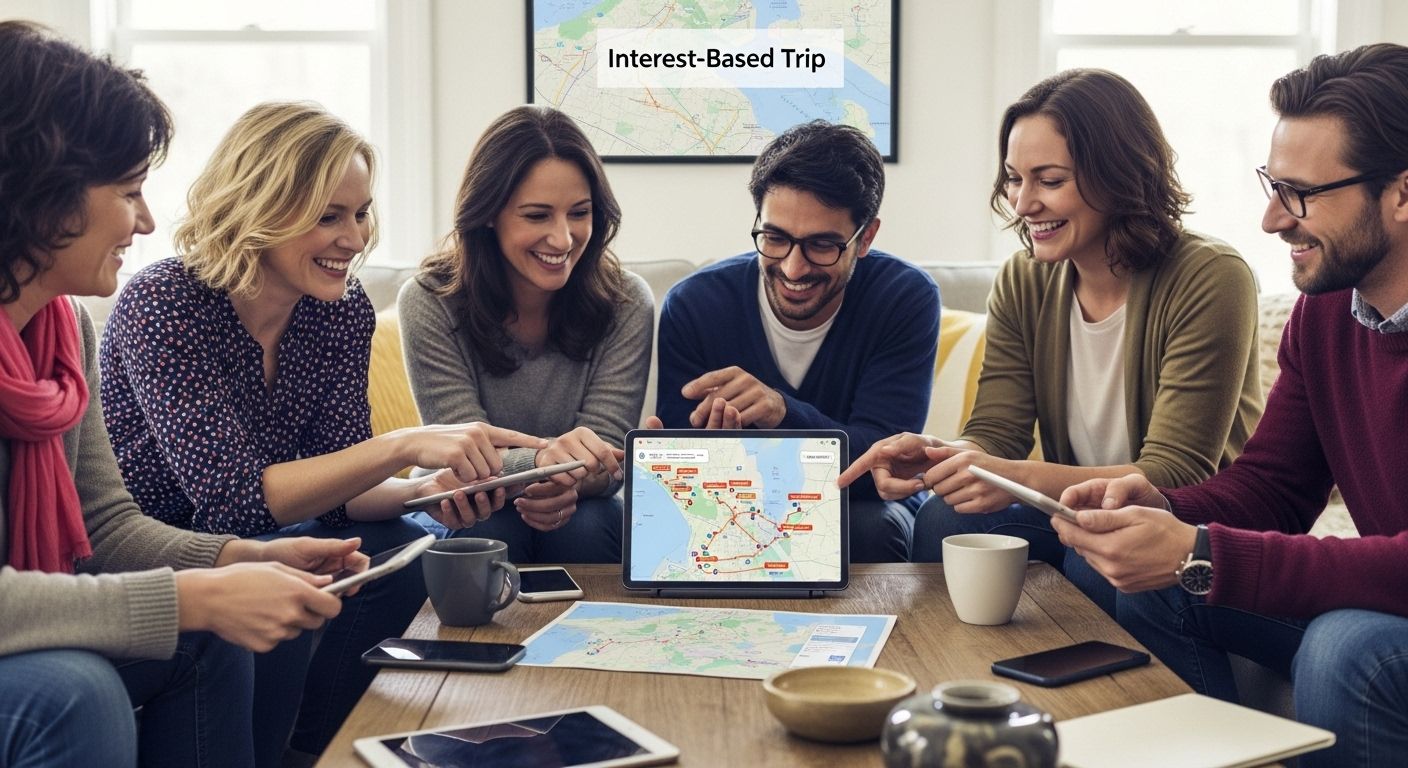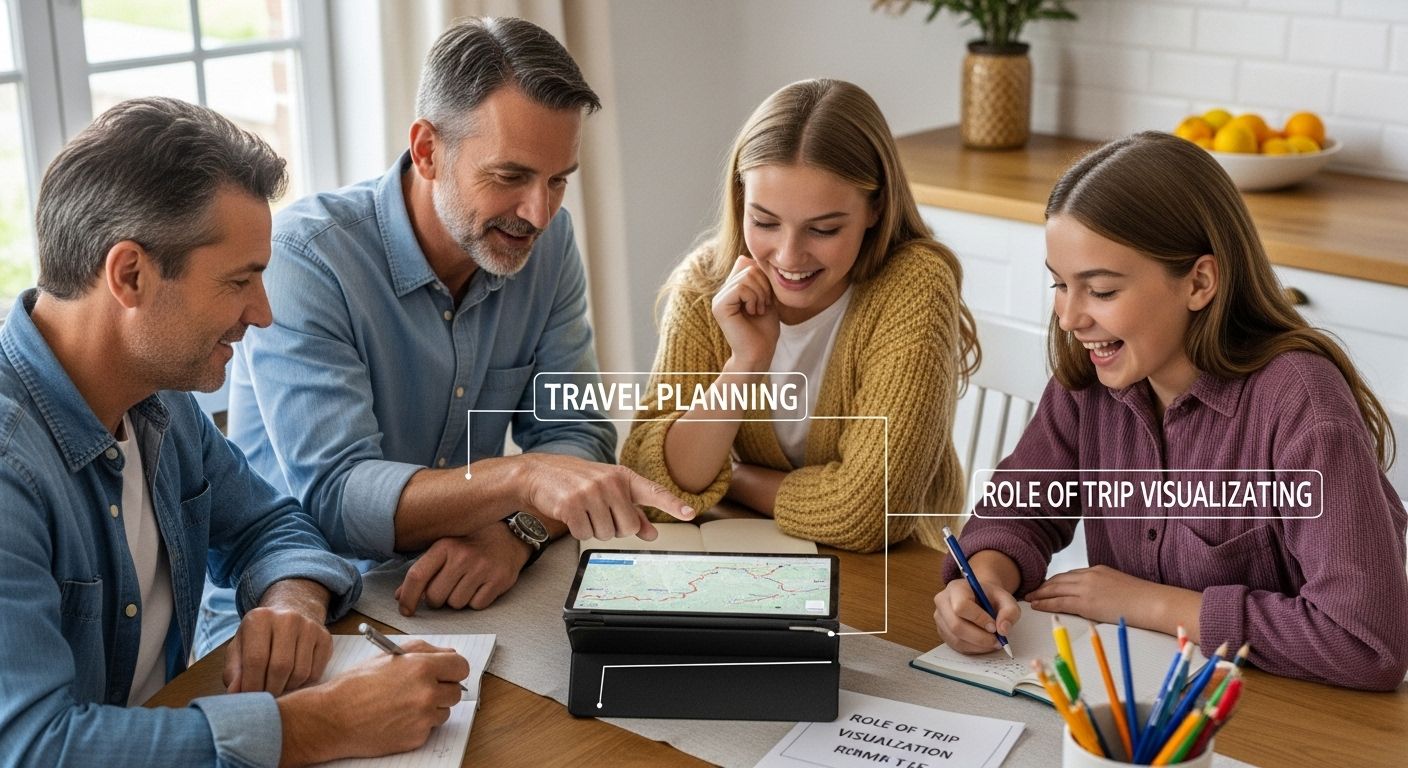Planning the ultimate beach trip sounds simple enough. Pick a spot, book a ticket, and pack your swimsuit, right? Not quite. Overlooking a few key details can turn a dream vacation into a headache, and the truth is travelers who carefully plan their trips save up to 30 percent on expenses just by choosing the right time to book and travel. Most people rush the process or skip steps entirely. The biggest surprise is how the best beach getaways come down to smart planning, not just sandy shores.
Table of Contents
- Step 1: Define Your Beach Destination
- Step 2: Create A Budget For Your Trip
- Step 3: Plan Your Travel Logistics
- Step 4: Research And Book Accommodations
- Step 5: Create An Itinerary Of Activities
- Step 6: Pack And Prepare For Your Trip
Quick Summary
| Key Point | Explanation |
|---|---|
| 1. Define your beach destination carefully | Consider personal interests, budget, and weather before selecting a beach location to ensure a satisfying trip. |
| 2. Create a detailed budget | Assess your finances and break down anticipated expenses to avoid surprises and enjoy your trip stress-free. |
| 3. Plan your travel logistics thoroughly | Organize transportation and accommodation details to ensure a smooth, hassle-free travel experience. |
| 4. Research and book accommodations wisely | Evaluate various lodging options and prioritize factors beyond price to enhance quality and enjoyment of your stay. |
| 5. Develop a flexible itinerary | Balance planned activities with free time to maximize your experience while staying open to spontaneous adventures. |
Step 1: Define Your Beach Destination
Choosing the perfect beach destination is the cornerstone of an exceptional beach trip. This initial step sets the foundation for your entire vacation experience, transforming a generic beach getaway into a personalized adventure tailored to your preferences and expectations. The process involves more than randomly selecting a coastal location it requires thoughtful consideration of multiple factors that will ultimately determine the quality of your trip.
Begin by conducting a comprehensive self assessment of your travel objectives. Are you seeking relaxation, adventure, cultural experiences, or a mix of these elements? Different beaches offer dramatically different atmospheres some provide serene tranquility with pristine landscapes, while others pulse with vibrant energy and numerous recreational activities. Consider your personal interests and vacation goals as your primary navigation tools.
Financial considerations play a crucial role in destination selection. Your budget will significantly influence potential locations, travel logistics, and overall trip duration. Some beach destinations offer luxurious experiences with premium pricing, while others provide equally stunning environments at more affordable rates. Research destination costs comprehensively including accommodation, dining, transportation, and activity expenses. Learn how to create a strategic trip budget to ensure your beach destination aligns with your financial parameters.
Weather patterns and seasonal variations are equally critical in beach destination planning. Research average temperatures, precipitation rates, and potential weather disruptions during your intended travel period. Some tropical locations experience significant rainy seasons that could compromise your beach experience, while others maintain consistent pleasant conditions year round. Understanding these nuances helps you select a destination that matches your climate preferences and minimizes potential travel complications.
Ultimately, successful beach destination selection requires balancing personal desires, practical constraints, and thorough research. Take time to explore multiple options, read traveler reviews, consult travel forums, and visualize yourself in each potential location. Your ideal beach destination is waiting to transform a simple trip into an unforgettable memory making experience.
Step 2: Create a Budget for Your Trip
Budget creation transforms your beach trip from a distant dream into a tangible reality. This critical step helps you understand exactly what financial resources you need to transform your vacation vision into an actual experience. A well constructed budget serves as your financial roadmap, preventing unexpected expenses and ensuring you can fully enjoy your beach getaway without constant monetary stress.
Start by conducting a comprehensive financial assessment of your current situation. Total your available discretionary funds and determine how much you can comfortably allocate to your beach vacation without compromising your financial stability. Consider not just the total trip cost, but also potential emergency reserves and ongoing financial commitments. Explore our detailed trip planning strategies to refine your budgeting approach and maximize your travel potential.
Break down your anticipated expenses into specific categories to create a granular understanding of potential costs. Accommodation typically represents the largest expense, so research thoroughly and compare prices across different platforms. Transportation costs including flights, rental cars, or local transit should be calculated next. Factor in daily expenses such as meals, beverages, activities, and entertainment. Many travelers underestimate incidental expenses like beach equipment rentals, souvenirs, or unexpected dining experiences, so build a modest buffer into your budget to accommodate these potential costs.
Understand the financial trade offs in your destination selection. Some beaches offer more budget friendly options with equally stunning environments, while others demand premium pricing for similar experiences. Research local economic conditions, currency exchange rates if traveling internationally, and seasonal pricing variations. Consider traveling during shoulder seasons when destinations offer lower prices but maintain excellent weather conditions. Flexibility in your travel dates can result in significant cost savings, sometimes reducing expenses by 20 to 30 percent compared to peak tourism periods.
Finalize your budget by creating a realistic spending plan that balances your financial constraints with your vacation desires. Your goal is not extreme frugality but smart, intentional spending that maximizes your enjoyment while maintaining financial responsibility. A well planned budget ensures your beach trip becomes a memorable experience rather than a source of financial stress.

Step 3: Plan Your Travel Logistics
Travel logistics represent the intricate skeleton of your beach vacation, transforming your dream trip from conceptual planning into practical execution. This critical step involves meticulously coordinating transportation, accommodation, and essential travel requirements that will determine the smoothness and enjoyment of your entire beach experience. Comprehensive logistics planning eliminates last minute stress and potential travel complications.
Explore our comprehensive trip planning strategies to streamline your preparation process and ensure nothing falls through the cracks. Begin by selecting your primary mode of transportation, which depends on your destination’s proximity and your personal preferences. Driving offers flexibility and potential cost savings, while flying might be necessary for more distant beach locations. Compare travel times, costs, and convenience factors to make an informed decision. Consider additional transportation needs like rental cars, shuttle services, or local public transit at your destination to ensure seamless mobility during your beach vacation.
Accommodation selection represents another crucial logistics component. Research multiple options that align with your budget and preferences, examining factors beyond simple pricing. Look into proximity to beach areas, available amenities, parking options, and surrounding neighborhood characteristics. Read recent traveler reviews to gain insights into actual experiences and potential hidden challenges. Some travelers prefer beachfront hotels for immediate ocean access, while others might choose more affordable options slightly removed from prime beach locations.
Prepare a comprehensive travel document checklist to prevent potential logistical nightmares. Gather and organize essential documents including identification, travel insurance, medical information, and any required reservations or confirmations. Create digital and physical backups of these documents, storing them in separate locations to mitigate risk of loss. Consider potential travel disruptions by having contingency plans for unexpected circumstances like flight delays, medical emergencies, or sudden weather changes.
Finalize your logistics by creating a detailed itinerary that outlines your travel schedule, including departure times, anticipated arrival windows, accommodation check in procedures, and transportation connections. A well structured itinerary provides a sense of security and helps you maximize your beach vacation experience by minimizing potential confusion or unexpected challenges. Remember that excellent logistics planning transforms travel from a potentially stressful experience into an enjoyable, seamless adventure.
Step 4: Research and Book Accommodations
Accommodation research and booking represent the cornerstone of your beach trip planning, transforming your destination dreams into a tangible travel experience. This critical step requires strategic thinking, thorough investigation, and careful consideration of multiple factors that extend far beyond simple price comparisons. Your chosen accommodation will significantly influence the overall quality and enjoyment of your beach vacation.
Begin your accommodation search by establishing clear priorities that align with your travel objectives and budget constraints. Consider the spectrum of lodging options available beach resorts, vacation rentals, boutique hotels, and budget friendly alternatives each offering unique advantages. Discover expert trip planning techniques to refine your accommodation selection process and uncover hidden opportunities. Examine each option through multiple lenses proximity to beach areas, amenities, accessibility, and potential additional fees that might not be immediately apparent in initial pricing.
Develop a systematic approach to comparing accommodations by creating a comprehensive evaluation matrix. Beyond basic pricing, assess factors like complimentary services, cancellation policies, customer reviews, and proximity to local attractions. Read recent traveler reviews critically, looking for consistent themes in feedback rather than isolated experiences. Pay special attention to reviews that discuss cleanliness, customer service, noise levels, and unexpected additional costs. Some travelers find tremendous value in less conventional accommodations like local guesthouses or apartment rentals that provide more authentic experiences and potential cost savings.
Here is a comparison table summarizing the main types of beach accommodations discussed in the article, helping you quickly evaluate which option best fits your travel needs and preferences.
| Accommodation Type | Key Features | Considerations |
|---|---|---|
| Beach Resort | Direct beach access, extensive amenities | Higher cost, often less privacy |
| Vacation Rental | Private space, kitchen facilities | Varies in quality, may have extra fees |
| Boutique Hotel | Personalized service, unique style | Limited rooms, can fill quickly |
| Budget-Friendly Option | Lower price, basic amenities | Fewer services, may be farther from beach |
| Guesthouse/Apartment | Authentic local experience, value pricing | May lack hotel-like services |
Navigate the booking process with strategic precision. Timing can significantly impact accommodation costs and availability. Book during shoulder seasons when possible to secure better rates and avoid peak tourist crowds. Consider flexible booking options that allow free cancellation or modification, providing a safety net for unexpected travel changes. Utilize price comparison websites, but also check direct hotel websites for potential exclusive deals or promotional offers not available through third party platforms.
Complete your accommodation booking by verifying all details meticulously. Confirm reservation specifics including check in times, parking arrangements, included amenities, and any special requirements you might have. Save all confirmation documents digitally and create physical backups. Your thorough preparation transforms accommodation booking from a potential source of stress into an exciting milestone in your beach trip planning journey.
Step 5: Create an Itinerary of Activities
Creating a comprehensive beach trip itinerary transforms your vacation from a loose collection of potential experiences into a structured, intentional adventure. This critical planning phase requires balancing spontaneity with strategic organization, ensuring you maximize every moment of your beach getaway while maintaining flexibility for unexpected opportunities. The perfect itinerary serves as a personalized roadmap that captures your travel desires without feeling overly restrictive.
Explore our comprehensive trip planning strategies to develop a more nuanced approach to activity selection. Begin by conducting thorough research about your destination’s unique offerings. Investigate local beach attractions, water sports opportunities, cultural experiences, and natural landmarks that align with your interests. Consider the diversity of activities available surfing lessons, snorkeling expeditions, sunset cruises, beach volleyball, local cuisine tours and prioritize experiences that resonate with your personal travel objectives.
Structure your itinerary with a thoughtful balance between planned activities and unstructured leisure time. Allocate approximately 60 to 70 percent of your trip to scheduled experiences, reserving the remaining time for spontaneous exploration. This approach prevents overscheduling while ensuring you do not miss key destination highlights. Group similar activities geographically to minimize travel time and reduce logistical complications.
Some travelers find success in creating a loose daily framework morning beach time, afternoon adventure activity, evening relaxation or cultural exploration that provides structure without feeling rigid.
Prioritize practical considerations when scheduling activities. Check local event calendars, verify operational hours for attractions, and understand seasonal variations that might impact availability. Research potential weather patterns and have backup indoor or alternative activities prepared in case of unexpected climate changes. Consider physical limitations and energy levels when planning particularly active experiences. Some beach destinations offer package tours or multi activity passes that can provide cost effective and logistically streamlined options for experiencing multiple attractions.
Finalize your itinerary by creating a digital and physical backup of your planned activities. Share your tentative schedule with travel companions or a trusted contact, ensuring someone knows your general whereabouts. Remember that the most memorable travel experiences often emerge from a delicate balance between careful planning and openness to unexpected adventures. Your meticulously crafted itinerary serves as a guide, not a strict mandate, allowing you to embrace the spontaneous magic of beach travel.
Step 6: Pack and Prepare for Your Trip
Packing represents the pivotal moment where your beach trip planning transforms from abstract strategy into tangible preparation. This critical step requires thoughtful consideration, strategic organization, and an understanding that what you bring can significantly impact your overall travel experience. Efficient packing is an art form that balances preparedness with minimalism, ensuring you have exactly what you need without being weighed down by unnecessary items.
Discover our comprehensive packing strategies to elevate your travel preparation game. Begin by analyzing your destination’s specific environmental conditions and planned activities. Beach destinations demand specialized gear beyond standard travel necessities lightweight, quick drying clothing, sun protection, water resistant accessories, and activity specific equipment like snorkeling gear or beach sports items. Consider the microclimate of your specific location tropical beaches require different preparation compared to more temperate coastal regions.
Develop a systematic packing approach that prioritizes versatility and efficiency. Select clothing items that can be mixed and matched, creating multiple outfit combinations while minimizing total volume. Invest in high quality, multipurpose items that serve multiple functions lightweight shirts that offer sun protection, convertible pants that transform into shorts, quick drying swimwear that doubles as athletic wear. Pack clothing in compression bags or rolling techniques that minimize wrinkles and maximize suitcase space. Consider the weight and potential baggage fees associated with your chosen luggage, selecting bags that provide optimal storage without incurring additional transportation costs.
Prepare a comprehensive travel preparedness kit that extends beyond clothing and personal items. Include essential documents like passport copies, travel insurance information, emergency contact details, and digital backups stored securely online. Pack a compact first aid kit with beach specific items like aloe vera, extra sunscreen, antihistamines, and any personal medications. Consider potential environmental challenges by including practical items like a portable phone charger, waterproof phone case, lightweight rain jacket, and a small emergency cash reserve. Your preparation transforms potential travel disruptions into manageable moments, allowing you to focus on enjoying your beach adventure.
This packing checklist table provides a concise overview of essential categories and items to consider when preparing for your beach trip, ensuring nothing important is forgotten.
| Category | Essential Items (Examples) | Purpose/Notes |
|---|---|---|
| Clothing | Lightweight tops, swimwear, shorts, sunhat | Sun protection, comfort, beach activities |
| Footwear | Flip-flops, water shoes, sandals | Beach, water sports, walking |
| Sun Protection | Sunscreen, sunglasses, lip balm, rash guard | Protection from UV rays |
| Travel Documents | ID/passport, insurance info, confirmations | Required for travel and emergencies |
| Electronics | Phone/charger, waterproof case, camera | Capture memories, stay connected |
| Health & Safety | First aid kit, medications, aloe vera | Address minor ailments and sunburn |
| Miscellaneous | Beach bag, reusable water bottle, towel | General convenience and hydration |

Turn Beach Trip Planning Stress Into Smooth Adventures With Yopki
Do you feel overwhelmed by the endless details of planning the perfect beach getaway? The article you just read breaks down how important it is to choose the right destination, manage your budget, keep track of logistics, and build a detailed itinerary. But even with the best advice, handling all these steps on your own can drain your excitement before the trip even begins. Key pain points like juggling accommodation research, creating the perfect itinerary, and making sure you never lose a reservation often turn planning into a chore instead of a pleasure.

Imagine if you could skip the hassle and control every step of your beach escape from one simple dashboard. With Yopki, you get a travel platform designed to make every part of your planning easier. Generate your personalized beach trip itinerary in seconds, keep all bookings and confirmations organized in one place, and rearrange plans with a simple drag-and-drop calendar. If needed, you can even let our expert team handle booking everything for you. Take the stress out of your next coastal getaway. Visit Yopki today and start building your unforgettable beach adventure—so you can focus less on logistics and more on making memories in the sand.
Frequently Asked Questions
How do I choose the right beach destination for my trip?
Selecting the ideal beach destination requires assessing your travel preferences, budget, and desired activities. Consider tranquility versus vibrant energy, costs related to accommodations and activities, and seasonal weather patterns to ensure the location aligns with your vacation goals.
What should be included in a beach trip budget?
Your beach trip budget should encompass all expenses related to accommodation, transportation, meals, activities, and incidentals. Include a buffer for unforeseen expenses like equipment rentals or additional dining, ensuring a stress-free financial experience during your trip.
How can I effectively plan travel logistics for my beach vacation?
To plan effective travel logistics, decide on your mode of transportation, research accommodation options, and prepare a checklist of necessary travel documents. Having a detailed itinerary can help manage schedules and reduce last-minute stress.
What factors should I consider when booking accommodations?
When booking accommodations, assess proximity to the beach, available amenities, cancellation policies, and read customer reviews. Prioritize options that align with your travel objectives, budget, and need for convenience and comfort.



